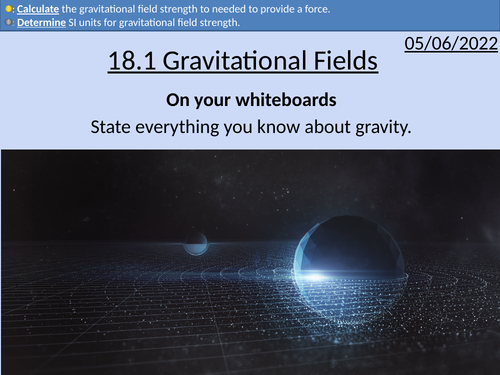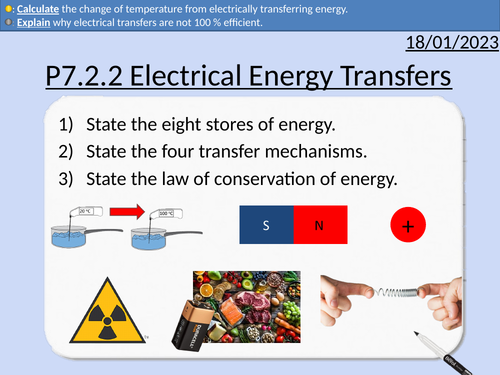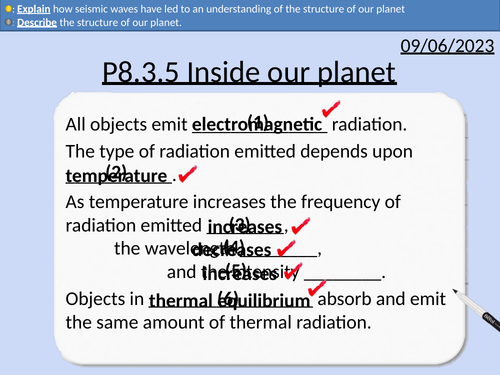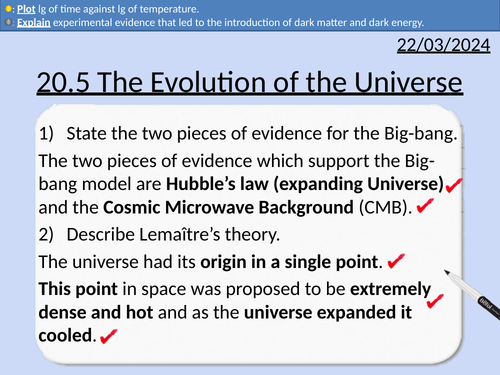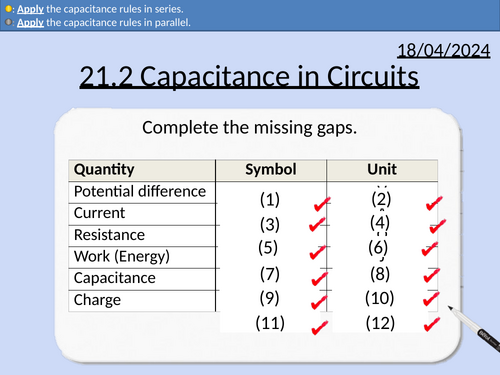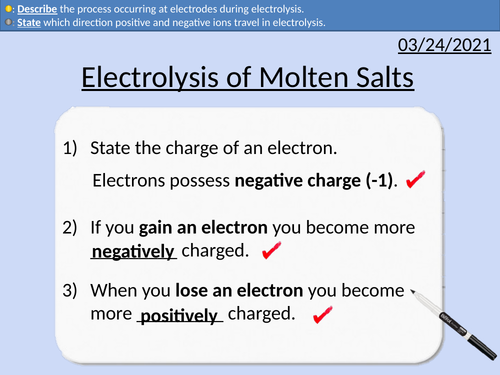496Uploads
163k+Views
70k+Downloads
Physics

GCSE Physics: Specific Latent Heat
This presentation covers OCR Gateway Physics 9-1 P1.2.4 Specific Latent Heat
Presentation covers
Changes of State - Phase changes
Interactive Graph
Equation with example
Questions with solutions for SLH equation
Exam style question with answer

OCR A level Physics: Specific Latent Heat
OCR A level Physics: Specific Latent Heat is a part of the Module 5: Newtonian World and Astrophysics. The PowerPoint presentation includes worked examples, solutions and a homework.

OCR A level Physics: Root mean square speed
OCR A level Physics: Root mean square speed is a part of the Module 5: Newtonian World and Astrophysics. The PowerPoint presentation includes worked examples, solutions and a homework.

OCR A Level Physics: Gravitational Fields
OCR A Level Physics: Gravitational Fields presentation, homework and answers.

GCSE Physics: Kinetic energy and Work done
This presentation covers OCR Gateway Physics 9-1 P7.1.1b Kinetic energy and Work done.
PowerPoint includes student activities with fully worked answers included.
Work done and kinetic energy equations
Rearranging equations
Mechanical energy transfer and work done
Kinetic store transfered mechanically to a thermal store through brakes.

GCSE Physics: Gravitational and Elastic Energy
This presentation covers OCR Gateway Physics 9-1 P7.1.7 Gravitational and Elastic Energy
Energy transfers with links to sport and PE.
Employer-mentor links with physics and sports
Exam Style Question with worked solutions
Rearranging equations
Practice Questions with worked solutions

GCSE Physics: Electrical Energy Transfers
This presentation covers OCR Gateway Physics 9-1 P7.2.2 Electrical Energy Transfers. All presentations come with student activities and worked solutions.
Energy stores
Energy transfers
Current heats wires
Wasted energy in motors and heating elements
Specific heat capacity and electrical energy
Thermal energy = Mass x Specific Heat Capacity x Change in Temperature
Energy = Charge x Potential Difference

GCSE Physics: Radiation and the body
This presentation covers OCR Gateway Physics 9-1 P6.2.1 Radiation and the body
This PowerPoint is a whole lessons included with student activities and animated answers.
Background radiation definition
Sources of background radiation
Contamination and irradiation
Medical examples of irradiation - X-rays, sterilisation, gamma knife
Medical examples of contamination - Tracers
Half-life and penetration power for radioactive tracers.

GCSE Physics: Inside our planet
This presentation covers OCR Gateway Physics 9-1 P8.3.5 Inside our planet
This PowerPoint is a whole lessons included with student activities and animated answers.
S and P waves
Structure of the Earth
Reflection, absorption, and refraction of waves
Sonar to map the ocean floor

GCSE Physics: Sound, Boundaries and Ultrasound
This presentation covers OCR Gateway Physics 9-1 P5.1.3 Sound Properties and Uses. Includes student activities and full worked answers.
Ray diagrams
Absorption, reflection and transmission
Sonar
Ultrasound
Rearranging equation
Refraction
Relationship between wave speed and wavelength
Data analysis

OCR A level Physics: Evolution of the Universe
OCR A level Physics: 20.5 Evolution of the Universe
Module 5 Newtonian World and Astrophysics
This PowerPoint is a whole lesson included with student activities, animated answers, homework questions with answers provided.
This lesson covers:
The evolution of the Universe from the Big-bang to 13.7 billion years later
The composition of the Universe
Experimental evidence for dark matter
Experimental evidence for dark energy

GCSE OCR Physics 9-1 Paper 1 Revision Booklets
OCR GCSE Physics Paper 1 for higher tier (triple and combined) are covered with individual revision booklets.
Each booklet has:
Link to specification number
Denotes if it is higher or combined material
Equations to recall and apply for that section
Equations to apply for that section
Key Points
Exam questions
Mark Schemes for each question
Triple Booklets:
P1.1 The Particle Model
P1.2 Changes of State
P1.3 Pressure
P2.1 Motion
P2.2 Newton’s Laws
P2.3 Forces in action - Simple Machines
P2.3 Forces in action - Springs and Gravitational Energy
P3.1/2 Electricity
P4.1 Magnetism
P4.2 Uses of Magnetism
Combined Booklets:
P1.1 The Particle Model
P1.2 Changes of State
P2.1 Motion
P2.2 Newton’s Laws
P2.3 Forces in action - Springs and Gravitational Energy
P3.1/2 Electricity
P3.3 Magnetism and Fields

GCSE OCR Physics 9-1 Paper 2 Revision Booklets
OCR GCSE Physics Paper 2 for higher tier (triple and combined) are covered with individual revision booklets.
Each booklet has:
Link to specification number
Denotes if it is higher or combined material
Equations to recall and apply for that section
Equations to apply for that section
Key Points
Exam questions
Mark Schemes for each question
Triple Booklets:
P5.1 Wave Beahviour and Wave Velocity
P5.2 Electromagnetic Waves
P5.3 Wave Interactions
P6.1 Radioactive Emissions
P6.2 Uses and Hazards - Fusion and Fission
P7 Energy
P8.1 Physics on the move
P8.2 Powering Earth
P8.3 Beyond Earth
Combined Booklets:
P4.1 Wave Beahviour and Wave Velocity
P4.2 Electromagnetic Waves
P4.3 Radioactice Emissions
P6 Energy
P6.2 Physics on the move
P6.3 Powering Eaerth

OCR A level Physics: Capacitors in Circuits
OCR A level Physics: 21.2 Capacitors in Circuits
Module 6 Particles and Medical Physics
This PowerPoint is a whole lesson included with student activities, animated answers, homework questions with answers provided.
This lesson covers:
Uses of capacitors in circuits.
Rules for capacitors in parallel (potential difference, charge, and capacitance).
Rules for capacitors in series (potential difference, charge, and capacitance).
Applying the rules in series and parallel.
Creating a circuit to calculate the charge stored on the capacitor.

OCR A level Physics: Uses of capacitors
OCR A level Physics: 21.5 Charging Capacitors
Module 6 Particles and Medical Physics
This PowerPoint is a whole lesson included with student activities, animated answers, homework questions with answers provided.
This lesson covers:
Calculating power output from a circuit containing a capacitor
A rectifier circuit - changing an alternating input to a smooth output

OCR A level Physics: Radioactivity
OCR A level Physics: 25.1 Radioactivity
Module 6 Particles and Medical Physics
This PowerPoint is a whole lesson included with student activities, animated answers, homework questions with answers provided.
This lesson covers:
Types of ionising radiation (alpha, beta-plus/beta-minus, gamma)
Penetration power and ionising power
Detecting radiation with a Geiger (GM tube) counter
Background radiation and correct count rates
Electric and magnetic fields affect ionising radiation
Cloud chambers

OCR A level Physics: Binding Energy
OCR A level Physics: 26.2 Binding Energy
Module 6 Particles and Medical Physics
This PowerPoint is a whole lesson included with student activities, animated answers, homework questions with answers provided.
This lesson covers:
Definition of mass defect
Definition of binding energy
Binding energy per nucleon
Calculating mass defect, binding energy, and binding energy per nucleon.
Explaining nuclear stability

OCR A level Physics: Radioactive Decay Calculations
OCR A level Physics: 25.4 Radioactive Decay Calculations
Module 6 Particles and Medical Physics
This PowerPoint is a whole lesson included with student activities, animated answers, homework questions with answers provided.
This lesson covers:
Decay constant and half-life
Using exponentials to calculate activity and number of nuclei present
Solving Differential Equations (beyond A-level Physics course)

GCSE to A level Physics: Bridging the Gap
A short booklet of questions for students to solve over the summer between GCSE and A level.

GCSE Chemistry: Electrolysis of molten salts
This PowerPoint presentation with worked examples and student questions covers:
• Naming electrolysis experimental set up
• PANIC convention for electrodes
• Electron transfers at electrodes
• Half-equations for anode and cathode




